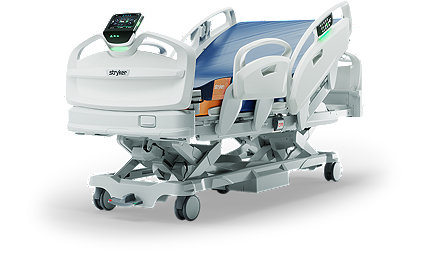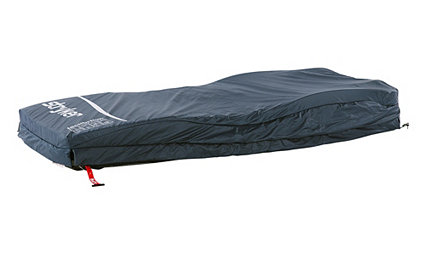How one medical center reduced pressure ulcers and saved costs
03-Sep-2024

3-minute read
91.7% decrease in HAPIs in the ICU saved an estimated $660,000 to $5,006,1001
2.5 million
Acute care patients who develop
a HAPI each year2
$20,000 to
$151,700
Cost of a single HAPI instance3
19.6%
Quarterly ICU HAPI rate increase from
one RN voluntarily leaving4
Hospital acquired pressure injuries (HAPI) – also known as pressure ulcers or bed sores – cause substantial patient harm and costs to hospitals.
Every year in the U.S., approximately 2.5 million acute care patients develop a HAPI.1 Patients who are elderly, immobile, malnourished, have poor skin quality or have extended hospital stays are at particularly high risk.5
The challenge of preventing HAPIs is acerbated by the nursing shortage, the continued exodus of nurses from the profession and short tenures. One study showed that on average per quarter in an intensive care unit (ICU), a single RN voluntarily leaving leads to a 19.6% increase in the HAPI rate.4
When preventive measures aren’t enough
With the prevention and treatment of HAPIs top of mind, ICU nurses follow well-recognized protocols. They take measures to avoid pressure on areas prone to developing bed sores. They assess and clean skin. They apply dressings and reposition patients.
And still, all too often, too many HAPIs occur.
A medical center’s journey to reducing HAPIs*1
At Bon Secours Southside Medical Center, nurse leaders wondered if a more advanced hospital bed – a state-of-the-art bed with an integrated, powered support surface – could make a difference in reducing HAPIs.
They conducted a study to find out.
Their adult ICU and adult cardiovascular ICU (CVICU) each had 14 beds and a patient population in poor health and at high risk for chronic diseases. During the study’s 10-month pre-intervention period, 36 HAPIs occurred in the ICU and eight occurred in the CVICU.
At the start of the intervention period, the 14 beds in the ICU were replaced with Stryker’s ProCuity ZMX bed frames with Isolibrium PE support surfaces. No change was made to the beds in the CVICU.
During the 20 months of the study, staff in both groups followed protocols designed to decrease pressure-related injuries. All were directed to continue to practice Q2 turning and repositioning, early assessment and early consults to wound care. They were advised to ensure pressure injury preventative measures were in place for high-risk patients as part of the care plan.
And what was the result?
In the ICU, where 36 HAPIs occurred during the pre-intervention period, only three occurred during the intervention period. In fact, during the final six consecutive months of the intervention period, no HAPI occurred in the ICU.
Meanwhile, in the CVICU, where no change was made to the beds, 20 HAPIs occurred during the intervention period.
The team concluded that preventive measures administered and conducted by hospital personnel can successfully limit the number of HAPIs only to a certain degree. When combined with these efforts, state-of-the-art patient bed technology can significantly decrease HAPI occurrence, leading to enhanced patient care and decreased hospital cost.
Based on the national average HAPI cost, a 91.7% decrease in the total number of HAPIs in the ICU saved Bon Secours Southside Medical Center an estimated $660,000 to $5,006,100.

Figure 1. Total number of HAPIs reported in the ICU before and after intervention.

Want to learn more? Access our e-Guide
As today’s healthcare landscape continues to evolve, frontline healthcare professionals are taking on more responsibilities amid ongoing turnover and a less-experienced workforce.4,6
If you’re striving to drive quality care in the ICU while navigating these challenges, access our e-Guide*, “Supporting pressure injury prevention in the ICU with ProCuity ZMX and Isolibrium PE: Strategies for enhancing patient care and helping to reduce cost.”
You’ll get a closer look at how Bon Secours achieved their results and learn about the hospital bed technology that made the difference. Perhaps best of all, you’ll discover how we can help your hospital use a data-driven approach to supporting HAPI prevention in the ICU, starting from wherever you are today.
Related
ProCuity ZMX
Designed to enhance safety and outcomes in the ICU while delivering a better experience for nurses and medical teams, with a focus on helping to reduce pressure injuries and supporting early mobility.
Learn moreIsolibrium/Isolibrium PE
The ICU support surface designed to help reduce pressure injuries.
Learn moreThe Science Behind Support Surfaces Registration
Stryker in partnership with Becker’s Health Review are presenting an on-demand webinar focusing on the utilization of support surfaces technology for prevention and treatment of pressure injuries.
Learn more*This case study describes the findings of a quality improvement initiative that incorporated ProCuity ZMX and Isolibrium PE with other evidence based HAPI prevention interventions. The hospital's results reflect the policies, protocols, technology and training implemented by the hospital and the results are not necessarily representative of what another hospital may experience.
1. Maass A, Dundalow JL. Case study: Quality Improvement Using Support Surfaces Effectively Decreases the Incidence of Hospital-Acquired Pressure Injuries. https://view.stryker.com/viewer/664646c192d58daa8e14d558. Retrieved May 17, 2024.
2. Padula WV, Delarmente BA. The national cost of hospital-acquired pressure injuries in the United States. International wound journal. 2019 Jun;16(3):634- 40. Retrieved May 16, 2024.
3. Agency for Healthcare Research and Quality, Rockville, MD. Are we ready for this change? Last reviewed October 2014. Retrieved May 16, 2024.
4. Peng D, Ye Y, et al. Journal of Operations Management. The impact of nurse staffing on turnover and quality: An empirical examination of nursing care within hospital units. March 26, 2023. Retrieved May 16, 2024.
5. Kayser SA, VanGilder CA, Lachenbruch C. Predictors of superficial and severe hospital-acquired pressure injuries: A cross-sectional study using the International Pressure Ulcer Prevalence™ survey. International journal of nursing studies. 2019 Jan 1;89:46-52. Retrieved May 16, 2024.
6. Intensive care unit nurse demographics and statistics in the US. www.zippia.com. Retrieved May 16, 2024.
AC-PRCY-COMM-1201444_REV-0_en_us



